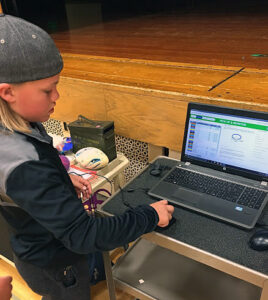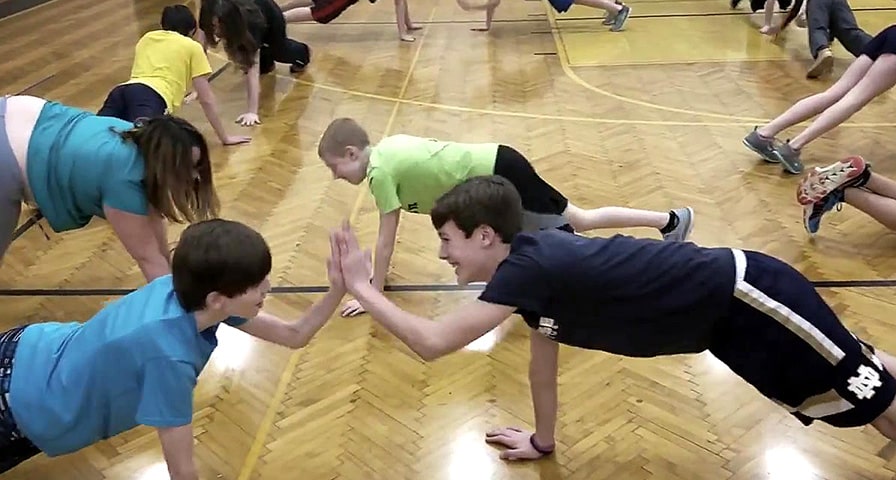Teachers who have turned to IHT ZONE heart rate monitors have seen their overall programs grow and the in-class performance and overall health of students improve.
From getting students to work together to teaching students that effort looks different for everyone, students are more engaged, more likely to meet goals and eager to reach them as a group when wearing heart rate monitors.
Encouraging Teamwork to Meet Daily Heart Rate Goals
As part of a complete overhaul of his PE program, San Bernardino CUSD specialist Scott Smith added the IHT ZONE to encourage students to stay active throughout each class. During one class session, he challenged students playing indoor soccer to keep their heart rates at a moderate activity level.
In addition to their actual heart rate, the IHT ZONE monitors show students what heart rate zone they are exercising in by changing colors:
- Blue indicates light effort, less than 60% of the student’s Max Heart Rate (MHR)
- Yellow indicates moderate physical activity, less than 70% of the student’s MHR
- Red indicates vigorous physical activity, up to 90% of the student’s MHR
“We wanted the kids in yellow,” Smith said of his soccer activity. “I told the group playing that if they all weren’t in the yellow zone by the end of the 6-minute game, they would all have to run around the gym floor twice.”
As the game wore on, students checked their IHT ZONE monitors to see if they had reached Smith’s target. Some who hadn’t yet upped their activity away from the ball.
“They understand,” Smith said. “It’s fascinating to watch because you see them doing things like jumping jacks when they aren’t near the ball.”
As Smith called out a one-minute warning, all 10 players simultaneously stopped playing soccer and began sprinting up and down the gym’s bleachers.
“They were doing it because they couldn’t get themselves out of the blue zone by playing soccer,” Smith said. “They were working together and talking and they figured out what they needed to do.”
Giving Students the Power to Succeed
In his fifth-grade class at Crestview School of Inquiry, Chris Amundson found a student who appeared content to stay in the shadows, staying active without exerting herself too much.
“She’s athletic and when we do any kind of testing or assessments, she does everything really well,” he said. “She just is someone who also likes to hide and make it look like she’s being active without pushing too hard because she doesn’t want to seem like an overachiever and doesn’t want to get sweaty because she’s a fifth-grade girl.”
When the teacher introduced the IHT ZONE and gave students goals based on their own fitness levels and abilities, he saw the student’s attitude change.
“The monitors have helped her have an outlet,” he said. “Now, she’s leading the pack. She’s pushing hard. She’s excited about what we’re doing.”
What exactly changed?
“She’s going all out because she’s motivated and she can see how active she is and how her body is reacting to all of this exercise,” he said. “It becomes them learning that it’s great to push yourself to new limits.”
Creating a Level Playing Field With Heart Rate Monitors
Teachers have long faced the dilemma of how to accurately assess the PE performance of students who range from uninterested to extremely athletic. For Portage Central Middle School teacher John Dunlop, the IHT ZONE heart rate monitor provided the ideal solution for his seventh-grade class.
“There is a boy who, in my 24 years (at that time) of teaching and coaching, is as athletic a kid as I’ve ever come across,” Dunlop explained. “Then there’s another boy who’s about a foot-and-a-half shorter than him. This boy hates PE, doesn’t really like school and he struggles a little academically. And they’re in the same class doing the same things. How do you meet the needs of both of these kids when you have them at the same time?”
Technology, as it turns out. When Dunlop introduced the heart rate monitors, the second student lit up.
“When we started using the heart-rate monitors, I saw a complete change in his attitude, especially at the end of class when he’s downloading and looking at his data,” Dunlop recalled. “He said, ‘hey, I did pretty good today.’”
That day justified what Dunlop had hoped to accomplish when he started using the monitors.
“I don’t know if that kid has ever experienced success in PE until this year,” Dunlop said. “Those are the kids you worry about. It’s the kids who this doesn’t come as easy for who need to experience success and get some feedback as to what they’re really doing.”
Teaching Students About Individual Assessment
 As much as teachers have always told students that effort doesn’t look the same for everyone, students can’t help but assume that a student who is running is working hard than a student who is walking. Teachers, too, have made that assumption.
As much as teachers have always told students that effort doesn’t look the same for everyone, students can’t help but assume that a student who is running is working hard than a student who is walking. Teachers, too, have made that assumption.
When her Rock River Intermediate School students started wearing the IHT ZONE, teacher Jackie Clark saw that assumption proven wrong and set about teaching her students what she had just learned.
“Many times some PE teachers assume that if a kid is not running they are not working hard,” Clark said. “In reality, an unfit child can be walking and still in their target heart rate zone.”
With data from each student’s heart rate report, Clark explained to one student – a cross country runner – why it was harder for him to reach her target zone than a student who could barely run.
“The biggest ah-ha moment was when one of my cross country runners downloaded their heart rate monitor one of those first days and was in their zone for only a couple minutes while a fellow student who was not that fit, was in their target heart rate zone 27 minutes and surpassed their goal of 21 minutes,” she said. “The cross country student was mad and didn’t think the monitors worked.”
Presented with a teachable moment, Clark explained the difference between the students.
“We had a great conversation about how his heart is much stronger than his fellow student who wasn’t as fit and that fitness is not one size fits all and I challenged him to get in his zone the next class period,” she said. “That was all the motivation he needed to prove to himself he could get in that zone.”


